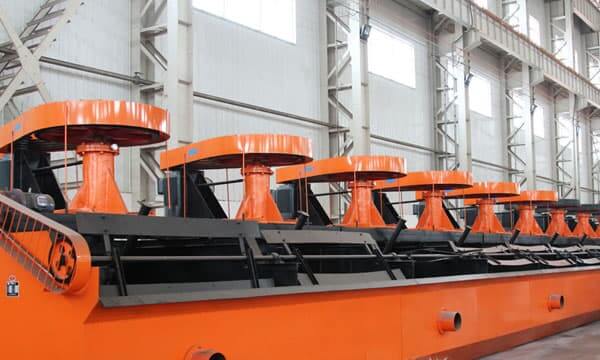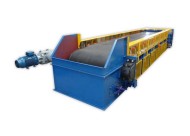Different types of copper ore usually contain different associated useful components. In addition to considering the recovery of copper ore, these ores also require targeted and comprehensive recovery of associated minerals. This has an important impact on the formulation of beneficiation process. Among the associated minerals of copper ore, lead-zinc ore, molybdenum ore and nickel ore are more common. This article will briefly discuss the comprehensive recovery of copper associated minerals around these three associated minerals.
Copper resources have the following characteristics:
- There are many small and medium-sized deposits, and few large and super-large deposits. The only deposits with copper reserves greater than 2.5 million tons are Jiangxi Dexing Copper Mine, Tibet Yulong Copper Mine, Jinchuan Copper-nickel Mine, Dongchuan Copper Mine, etc. Among the proven mineral deposits, only 3% are large and super large, 9% are medium and 88% are small.
- More lean ore, less rich ore. The average grade of copper mines in China is 0.87%, and the reserves of copper mines with a grade greater than 1% account for 35.2% of the country’s total copper mine reserves. Among large copper mines, copper reserves with grades greater than 1% only account for 13.2%.
- There are many co-associated mines, but few single mines. Among the more than 900 ore deposits, only 27.1% are single ore deposits, and 72.9% are comprehensive ore deposits, which have great comprehensive utilization value.
Comprehensive Recovery of Associated Lead-zinc Ore
Associated lead-zinc deposits mainly occur in skarn copper deposits, pyrite copper deposits and sandstone copper deposits, and the beneficiation processes of the three recovered deposits are quite different. Skarn-type or sandstone-type copper deposits are usually accompanied by two minerals, lead sulfide and zinc sulfide, and flotation is the main method of choice. In the selection process, the copper-lead-zinc preferential flotation process, the copper-lead mixed separation-tailings zinc flotation process, and the copper-lead-zinc mixed flotation-copper-lead-zinc separation process can be considered. Such as floating – copper-lead-zinc-sulfur asynchronous mixing – copper-lead-zinc-sulfur separation process, etc.
Method: Massive sulfide copper deposits of volcanic origin usually contain associated zinc, mainly sphalerite or sphalerite, and these deposits contain substantial amounts of pyrite or magnetic pyrite. It is easy to oxidize during mining, crushing and grinding, and the oxidized surface can seriously affect the flotation speed of copper, zinc and sulfur minerals. In addition, some metal cations in the ore will activate the zinc-sulfur minerals and affect the recovery of copper and zinc minerals. Usually, most of the lead-zinc sulfide ore adopts the preferential flotation process. Generally, “floating lead and zinc suppression” is used mainly because galena has good floatability, and it is difficult to activate after galena is inhibited. In addition, it is found in most lead-zinc sulfide ores. The content of zinc is higher than that of lead, and “floating less and suppressing more” is often more reasonable both technically and economically. The characteristics of this type of ores are that the content of lead and zinc is relatively high, and the inlaid cloth of lead and zinc is not very close, or is not inlaid in aggregates.
Therefore, the beneficiation process and reagent system of these ores are relatively complex, including pretreatment priority flotation, copper-zinc mixed flotation and re-separation, and two-stage flotation method.
Comprehensive Recovery of Associated Molybdenum Ore
Molybdenum minerals are often found in porphyry copper deposits, mainly in the form of molybdenite. Copper ore mainly exists in the form of chalcopyrite and speckled copper ore. Molybdenum has a high comprehensive recovery value. When the associated molybdenum grade reaches 0.01%, comprehensive recovery of molybdenite can be considered, which is one of the main sources of molybdenum ore.
Molybdenite crystals have a hexagonal layered or plate-like structure, which is formed by the S-Mo-S structure along the interlayer paradigm bond and the polar covalent bond S-Mo in the layer. The bonding force between layers is very weak, while the covalent bonding force within the layer is very strong. Therefore, molybdenite is easily decomposed along the structural layers and produced in flake or plate shape, which is the reason for the good natural floatability of molybdenite. For the selection of molybdenite, it is necessary to avoid and prevent over-grinding. In production, it is necessary to adopt the process of stage grinding and multi-stage separation. The monomer dissociation is gradually achieved to ensure a high recovery rate of molybdenum concentrate.
Method: As the floatability of molybdenite is similar to that of copper sulfide minerals, preferential flotation processes will be avoided when selecting a mineral recovery process. The more commonly used process flow includes copper and molybdenum mixed flotation-copper and molybdenum separation process, rough concentrate regrinding stage flotation process, partial preferential flotation process, fast preferential flotation process, etc. Molybdenum is recovered from porphyry copper ore, and copper-molybdenum mixed roughing is generally used in beneficiation. Then carry out the pretreatment before the separation of copper and molybdenum: concentration and drug removal, cooking, regrinding, etc., followed by separation of copper and molybdenum and selection of molybdenum. When the molybdenum grade in the raw ore is low, the molybdenum concentrate is difficult to separate from the copper and molybdenum mixed concentrate. Usually a partial preferential flotation process or a fast preferential flotation process is used.
Comprehensive recovery of associated nickel ore
Associated nickel ore mainly occurs in copper-nickel sulfide copper ore, copper ore mainly exists in the form of chalcopyrite, and Nickel mainly exists in the form of free nickel sulfide such as pyrite, goethite, and pyrite. A considerable part of nickel occurs in pyrrhotite in a similar manner, and there is also a small amount of nickel silicate. According to different ore structures, the comprehensive recovery process of copper-nickel sulfide deposits mainly includes stage grinding-stage flotation, copper-nickel mixed flotation-copper-nickel separation, copper preferential flotation-copper-nickel mixed flotation, flotation, etc.
Method: Collectors and foaming agents for flotation of copper sulfide minerals are often used. A basic principle in determining the flotation process is to prefer copper to nickel concentrates and to avoid nickel from copper concentrates as much as possible. Because the nickel in the copper concentrate is lost in the smelting process, the copper in the nickel concentrate can be recovered more completely. In production practice, when the copper ore particles in the deposit are fine and the nickel ore flotation speed varies greatly, the stage grinding stage flotation process can be used to obtain different grades of nickel concentrate. When the copper mineral particles are relatively coarse, the copper preferential flotation-copper-nickel mixed flotation process can be used.
The above is the comprehensive beneficiation and recovery process of three common minerals associated with copper mines. It is important to note that accompanying minerals are an important consideration during the process. However, mineral structure, mineral intercalation relationship, and useful mineral intercalation granularity also have important influences, which need to be considered comprehensively. It is recommended to conduct beneficiation tests according to the appropriate technological process and more specific beneficiation process to avoid economic losses and waste of resources.










